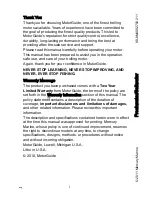4.1 On-board Debugger
The on-board debugger is a SEGGER J-Link debugger running on an EFM32 Giant Gecko. The debugger is directly connected to the
debug and VCOM pins of the target EFR32MG24.
When the debug USB cable is inserted, the on-board debugger is automatically activated, and takes control of the debug and VCOM
interfaces. This means that debug and communication will
not
work with an external debugger connected at the same time. The on-
board LDO is also activated, providing power to the board.
When the USB cable is removed, the board might still be running on battery power, as described in section
. In this
case, the on-board debugger goes into a very low power shutoff mode (EM4S), consuming about 80 nA. This means that battery life-
time will not be affected too much by the on-board debugger power consumption. Since the I/O voltage rail of the debugger remains
powered in the battery-operated mode, the pins connected to the debug and VCOM interfaces maintain proper isolation and prevent
leakage currents.
4.2 External Debugger
A Wireless mainboard with a debug adapter board from Silicon Labs can be connected to the Mini Simplicity Connector and used for
debugging instead of the on-board debugger. For instruction on using the mainboard for debugging, see "AN958: Debugging and Pro-
gramming Interfaces for Custom Designs". Debugging with an external Wireless mainboard gives access to the following debugging
features:
• Debugging of the target device through SWD
• Communication using the VCOM port
• Packet Trace Interface (for wireless devices only)
• Advanced Energy Monitor
Note that the Mini Simplicity Connector
cannot
be used at the same time that the on-board debugger is active (USB cable is plugged
in). For information on how to correctly connect to the kit, see
Figure 4.1 xG24 Dev Kit Debugging Possibilities on page 21
Powering the board when using the Mini Simplicity Connector with a Wireless mainboard and adapter board can be done using the
AEM voltage supply of the Wireless mainboard. When doing this, remove both the USB cable and the coin cell battery from the xG24
Dev Kit before connecting the Wireless mainboard to the Mini Simplicity Connector. The power switch on the Wireless mainboard
should be set in "AEM". Power-cycling of the board, if necessary, can easily be done by flipping the power switch on the Wireless to
"BAT" and back to "AEM" assuming a battery is not inserted in the Wireless mainboard.
It is possible to have the xG24 Dev Kit powered by a battery, and still use the Mini Simplicity Connector with a Wireless mainboard for
debugging and communication. In this case, the power switch on the Wireless mainboard must be set to the "BAT" position and the
coin cell battery on the Wireless mainboard must be removed. In this case, level shifters on the Wireless mainboard itself take care of
interfacing to different voltage levels on the xG24 Dev Kit. Connecting the board to an external debugger in other ways than those de-
scribed above might create power conflicts, compromise the ability to monitor power consumption, and hazardously feed power back to
the on-board battery.
Important:
Always remove the battery if you are not sure whether the external debugger is sourcing voltage to xG24 Dev Kit.
4.2.1 External Debugger Considerations
4.2.1.1 Pull-Up Resistor on Reset
A small current may be injected into the VDCDC rail when using an external debugger that has a pull-up resistor to VMCU on the reset
line. The debugger on the Wireless mainboards features a 100 kΩ pull-up resistor, and the following paragraph explains what happens
when a Wireless mainboard with a debug adapter board is connected to the xG24 Dev Kit.
The debugger on a Wireless mainboard features a pull-up resistor on the debug reset signal that connects to a buffered version of the
power supply net VMCU when using the debug adapter board (BRD8010A). As the RESETn pin on the EFR32MG24 is connected to
the DVDD pin through a pull-up resistor inside the chip, an electric path is created between the buffered VMCU rail on the Wireless
mainboard and DVDD on the xG24 Dev Kit. On xG24 Dev Kit, DVDD is connected to the output of the EFR32MG24's dc-dc buck regu-
lator (VDCDC) and current will flow from the buffered VMCU rail to the VDCDC net when VDCDC is regulated down to a voltage less
than VMCU. The injected current will cause erroneous current consumption and current measurements, and raise the voltage on the
VDCDC rail if the total current consumption of the VDCDC rail is less than the injected current. At the time of writing, the combination of
the two pull-up resistors is 144 kΩ (typ) which would lead to ~10 µA injected current on VDCDC assuming VMCU is 3.3 V and VDCDC
is 1.8 V.
UG524: xG24 Dev Kit User's Guide
Debugging
silabs.com
| Building a more connected world.
Rev. 0.1 | 22

















